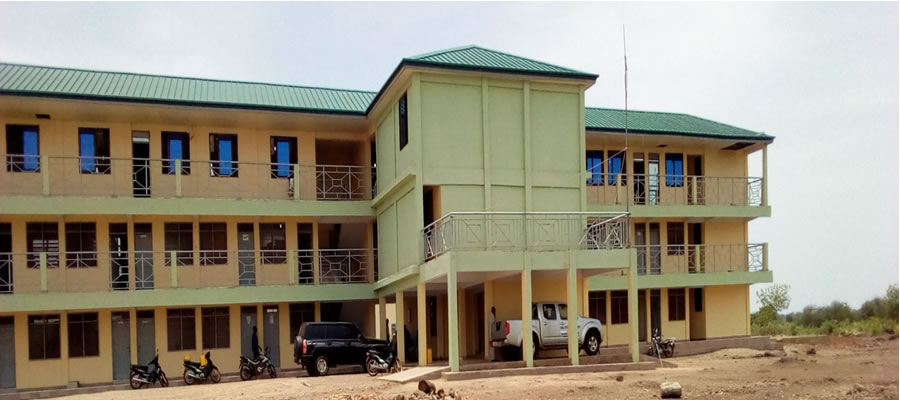

Population Size
According to the 1984 population census, the district had a population of 65529.The 2000 Population and Housing Census put the population of the district at 82716-this gives the district a population growth rate of 1.5 % per annum, which is below the regional and national growth rates of2.3% and 2.7 %. respectively.
The above growth trend shows that all other things being equal the district’s population will double in 43 years time. Nonetheless with this rate of population growth, there is still pressure on existing socio-economic infrastructure. Thus, there u the need for efforts to be channeled to meet the demands of the population while putting measures in place to check increases in tins growth rate.
Density
The population density is about 31,0 persons per square kilometer and not evenly distributed. For instance, whereas areas around Nadowli and Kaleo have densities of about 50 persons per square kilometer, the eastern part of the district has densities of about 15 persons per square kilometer.
This uneven population concentrations is due to the over concentration of socio-economic infrastructure facilities and services in the Western portion of the district to the neglect of areas in the east.
Age- Sex Distribution
The age-sex structure of the district is typical of the rural Ghanaian situation. The population pyramid has a broad base which tippers to the top. About 45% of (lie population age between 0-14 years while 49% constitutes the economic active population will) the remaining 6% being aged. .The high proportion of children in the district gives an indication of the need to provide child care facilities such as Day Care Centers, Primary Schools, Clinics and the like.
The population is also made up of 39375 males and 43341 females giving a male / female ratio of 80:100 as compared with the national male / female ratio of 97.9:100. The predominance of women calls for policies to address women’s problems in the district. This is more imperative in view of the fact that though women especially those in the deprived areas are a vulnerable group their productive abilities cannot be underestimated.
Dependency Ratios
From the above it could be discerned that the district has an age dependency ratio of 1:1 .04 meaning that if all the people in the labour force were working, 100 workers would have 104 dependants. However since only 96% of the labour forces are working, the economic dependency ratio of the district stands at 1: 1.12 meaning that 100 workers have 112 dependants compared with the national ratio of 1:0.871.
Migration
There is no statistical data on migration trends in the district however the situation docs exist. There is seasonal out-migration by the youth especially males to the south to work thereby reducing the labour force whilst there is also intra-district migration from the west to the fertile east to farm. The out migration of the youth has serious implications for the embryonic economy of the district, as the potentials for production are lost to other districts.
Human Settlement
This section deals with the organization of human and economic activities in space with regard to the district. It is particularly concerned with the type, number and distribution of infrastructure facilities and services within the district. This is to assess the adequacy of these facilities and services, variety of functions performed by the various settlements and hierarchy of the settlements.
Population Distribution by Settlements
By the national standard for the definition of an urban settlement, none of the settlements in the Nadowli district is urban, implying that the district is a typical rural district. Only eleven (11) settlements are with populations above 2000.
In terms of distribution, the district’s population is concentrated in the western part of the district. Therefore, most of the major settlements are also concentrated around this portion with the high-density areas around the district capital Nadowli.
The uneven distribution of the districts population partly exp, the over concentration of social and economic infrastructure in the western portion of the district to the neglect of other areas. Thus, the formulation of policies that will ensure equity in the dist; of resources needs to be vigorously pursued.
Location and Distribution of Services and Facilities
The distribution of services and facilities in the district are inadequate and also skewed towards Nadowli the district capital and other major settlements in the district - Kaleo, Issa, Daffiama,
Sankana and Nator.
Since most of the major settlements are also located at the western part of the district and have attracted better social economic infrastructure, it is therefore not surprising that this portion of (lie district has the highest social and economic interaction. The above assertion is one of the major factors that has influenced the existing spatial pattern of the district’s development.
Thus, if economic development is to be achieved with greater social and geographical equity, investment but be made in a pattern of "decentralized concentration". That is, they must be strategically located in settlements that: can serve a large population living in and around them, and to which people living at relatively low density areas of the district have easy access.
Special Analysis of the Settlements System
This analysis is to provide a better understanding of the fundamental characteristics of the settlements and the satisfactory description of the settlements hierarchy. The scalogram and Weighted Centrality indexes method has been applied for the spatial analysis of the settlement system to give a practical impression about the functions that settlements perform in the district.
This will assist in a way to determine which settlements lack which services or facilities. It will also help in making future location decisions about new investments for settlements in the district. Based on the number and type of services and facilities available (that is in the scalogram), the weighted centrality indexes of the major settlements are analyzed which eventually ranks the settlement.
In constructing the districts scalogram, a total of twenty- four (24) functions were considered un presence or absence basis for all the selected settlements. The settlements in the district include in the analyses were selected using population size and four (4) services/facilities namely primary school, feeder road, and periodic market and pit latrine were used as cut-off.
Hierarchy Settlements
The hierarchy of settlements in tile district was distinguished by calculating the centrality index of each of the selected settlements as a percentage of the total weighted index of 752.23 used the following quintet bands as the criteria the hierarchy of the selected settlements of the district were identified:
(1). All settlement whose centrality indexes fall between 80 and 100 percent of the total weighted Centrality of 752.23.
(2). All settlement whose centrality indexes fall between 60 and 79 percent of the total weighted Centrality of 752.23.
(3). All settlement whose centrality indexes fall between 40 and 59 percent of (lie total Weighted centrality of 752.23.
(4). All settlement whose centrality indexes full between 20 and 39 percent of the total Weighted centrality of 752.23.
(5). All settlement whose centrality indexes fall between 20 percent of the total weighted Centrality 752.23.
The analysis revealed that the district has levels 1,3,4 and 5 settlements. Nadowli is the only level 1 settlement therefore by function it provides the highest level of service in the district, Even though Kaleo has the highest population amongst the settlement sampled, it is a level III settlement.
The implies that there is no direct correlation between population and the number of services and facilities provided in a given settlement in the district. Also, the district is dominated by level V settlements indicating the inadequacy of the facilities and services in providing the basic needs of the population.
Environmental Situation
The quality of both the built and the natural environments is vital for the long-term growth and development of the district. Increased production can only be meaningful on the one hand when it occurs in well-managed, amenable, efficient, safe and healthy built environments. On the other hand, protection and the natural environment to prevent deforestation, land degradation, and loss of
ecosystems is paramount. Thus the district’s natural and built environments have been examined inthis section.
Natural Environment
Human activities, particularly annual routine bush burning, inappropriate farming practices, indiscriminate tree felling for fuel wood and charcoal and poor animal husbandry practices have led to increasing loss of the vegetative cover of the district, which in effect, has given way to soil erosion and depletion of soil fertility.
Farming along and in watercourses has also brought about the silting of water bodies like dams and ponds and destruction of the vegetation protecting the water bodies. In addition, road construction coupled with sand and gravel winning has caused a great dent in the natural environment.
Currently, the quest for the protection of the natural environment is gradually taking roots in the district. A manifestation of this is the existence of women groups in agro-forestry District wide. Economic trees like cashew and mango plantations are also gaining grounds in the district Individuals have also adopted (lie habit of planting Lees around their buildings.
Built Environment
The built environment of the district leaves much to be desired. The current state of the district’s built environment is traceable to poor attitude towards sanitation and personal hygiene practices, poor special planning, poor waste management, weak enforcement of byelaws, inadequate sanitation staff inadequate water and sanitation facilities.
With the absence of effective development control machinery in the district, physical development has been haphazard and uncoordinated leading to incompatible land uses especially in the major settlements.
Worse still, the general absence of drains in the district has exposed most communities to severe erosion. Thus far, rills, gullies and exposed foundation of buildings are common features in the district’s built environment.
Even though some gains have been made in protecting the natural environment and enhancing the built environment, the following still remains as teething issues:
- Deforestation - bush burning/fire and forestry management;
- Land degradation;
- Inadequate sanitation and hygiene practices and
- Low awareness/recognition of environmental issues.
Date Created : 11/16/2017 1:44:37 AM










 facebook
facebook
 twitter
twitter
 Youtube
Youtube
 +233 593 831 280
+233 593 831 280 0800 430 430
0800 430 430 GPS: GE-231-4383
GPS: GE-231-4383 info@ghanadistricts.com
info@ghanadistricts.com Box GP1044, Accra, Ghana
Box GP1044, Accra, Ghana